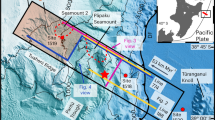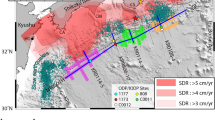Abstract
The 2011 Tōhoku-Oki earthquake revealed that co-seismic displacement along the plate boundary megathrust can propagate to the trench. Co-seismic slip to the trench amplifies hazards at subduction zones, so its historical occurrence should also be investigated globally. Here we combine structural and experimental analyses of core samples taken offshore from southeastern Costa Rica as part of the Integrated Ocean Drilling Program (IODP) Expedition 344, with three-dimensional seismic reflection images of the subduction zone. We document a geologic record of past co-seismic slip to the trench. The core passed through a less than 1.9-million-year-old megathrust frontal ramp that superimposes older Miocene biogenic oozes onto late Miocene–Pleistocene silty clays. This, together with our stratigraphic analyses and geophysical images, constrains the position of the basal decollement to lie within the biogenic oozes. Our friction experiments show that, when wet, silty clays and biogenic oozes are both slip-weakening at sub-seismic and seismic slip velocities. Oozes are stronger than silty clays at slip velocities of less than or equal to 0.01 m s–1, and wet oozes become as weak as silty clays only at a slip velocity of 1 m s–1. We therefore suggest that the geological structures found offshore from Costa Rica were deformed during seismic slip-to-the-trench events. During slower aseismic creep, deformation would have preferentially localized within the silty clays.
This is a preview of subscription content, access via your institution
Access options
Access Nature and 54 other Nature Portfolio journals
Get Nature+, our best-value online-access subscription
$29.99 / 30 days
cancel any time
Subscribe to this journal
Receive 12 print issues and online access
$259.00 per year
only $21.58 per issue
Buy this article
- Purchase on Springer Link
- Instant access to full article PDF
Prices may be subject to local taxes which are calculated during checkout



Similar content being viewed by others
References
Ito, Y. et al. Frontal wedge deformation near the source region of the 2011 Tohoku-Oki earthquake. Geophys. Res. Lett. 38, L00G05 (2011).
Fujiwara, T. et al. The 2011 Tohoku-Oki earthquake: displacement reaching the trench axis. Science 334, 1240–1240 (2011).
Satake, K., Fujii, Y., Harada, T. & Namegaya, Y. Time and space distribution of coseismic slip of the 2011 Tohoku earthquake as inferred from tsunami waveform data. Bull. Seismol. Soc. Am. 103, 1473–1492 (2013).
Wang, K. L. & Hu, Y. Accretionary prisms in subduction earthquake cycles: the theory of dynamic Coulomb wedge. J. Geophys. Res. 111, B06410 (2006).
Chester, F. M. et al. Structure and composition of the plate-boundary slip zone for the 2011 Tohoku-Oki earthquake. Science 342, 1208–1211 (2013).
Ikari, M. J., Kameda, J., Saffer, D. M. & Kopf, A. J. Strength characteristics of Japan Trench borehole samples in the high-slip region of the 2011 Tohoku-Oki earthquake. Earth Planet. Sci. Lett. 412, 35–41 (2015).
Faulkner, D. R., Mitchell, T. M., Behnsen, J., Hirose, T. & Shimamoto, T. Stuck in the mud? Earthquake nucleation and propagation through accretionary forearcs. Geophys. Res. Lett. 38, L18303 (2011).
Ujiie, K. et al. Low coseismic shear stress on the Tohoku-Oki megathrust determined from laboratory experiments. Science 342, 1211–1214 (2013).
Moore, J. C., Plank, T. A., Chester, F. M., Polissar, P. J. & Savage, H. M. Sediment provenance and controls on slip propagation: Lessons learned from the 2011 Tohoku and other great earthquakes of the subducting northwest Pacific plate. Geosphere 11, 533–541 (2015).
Horn, D. R., Horn, B. M. & Delach, M. N. Sedimentary provinces of the North Pacific. Geol. Soc. Am. Mem. 126, 1–22 (1970).
Ikari, M. J., Niemeijer, A. R., Spiers, C. J., Kopf, A. J. & Saffer, D. M. Experimental evidence linking slip instability with seafloor lithology and topography at the Costa Rica convergent margin. Geology 41, 891–894 (2013).
Kurzawski, R. M., Stipp, M., Niemeijer, A. R., Spiers, C. J. & Behrmann, J. H. Earthquake nucleation in weak subducted carbonates. Nat. Geosci. 9, 717–722 (2016).
Namiki, Y., Tsutsumi, A., Ujiie, K. & Kameda, J. Frictional properties of sediments entering the Costa Rica subduction zone offshore the Osa Peninsula: implication for fault slip in shallow subduction zones. Earth, Planets and Space https://doi.org/10.1186/1880-5981-66-72 (2014).
Arroyo, I. G., Grevemeyer, I., Ranero, C. R. & von Huene, R. Interplate seismicity at the CRISP drilling site: The 2002 Mw 6.4 Osa Earthquake at the southeastern end of the Middle America Trench. Geochem. Geophys. Geosyst. 15, 3035–3050 (2014).
Bangs, N. L., McIntosh, K. D., Silver, E. A., Kluesner, J. W. & Ranero, C. R. Fluid accumulation along the Costa Rica subduction thrust and development of the seismogenic zone. J. Geophys. Res. Solid Earth 120, 67–86 (2015).
Charpentier, D. et al. Mineralogy and fluid content of sediments entering the Costa Rica subduction zone—results from Site U1414, IODP Expedition 344. In AGU Fall 2013 Meeting abstr. T34C-04 (American Geophysical Union, San Francisco, 2013).
Kameda, J. et al. Pelagic smectite as an important factor in tsunamigenic slip along the Japan Trench. Geology 43, 155–158 (2015).
Harris, R. N. et al. In Proc. IODP Vol. 344 (IODP, Texas, 2013); https://doi.org/10.2204/iodp.proc.344.101.2013
Gorman, P. J., Kerrick, D. M. & Connolly, J. A. D. Modeling open system metamorphic decarbonation of subducting slabs. Geochem. Geophys. Geosyst. 7, GC001125 (2006).
Kerrick, D. M. & Connolly, J. A. D. Metamorphic devolatilization of subducted marine sediments and the transport of volatiles into the Earth’s mantle. Nature 411, 293–296 (2001).
Di Toro, G. et al. From field geology to earthquake simulation: a new state-of-the-art tool to investigate rock friction during the seismic cycle (SHIVA). Rendiconti Lincei 21, 95–114 (2010).
Vannucchi, P. et al. In Proc. IODP Vol. 334 (Integrated Ocean Drilling Program Management International, Inc., Tokyo, 2012); https://doi.org/10.2204/iodp.proc.334.2012
Smith, S. A. F. et al. Coseismic recrystallization during shallow earthquake slip. Geology 41, 63–66 (2013).
Uchide, T. High-speed rupture in the first 20 s of the 2011 Tohoku earthquake, Japan. Geophys. Res. Lett. 40, 2993–2997 (2013).
Piatanesi, A., Tinti, S. & Gavagni, I. The slip distribution of the 1992 Nicaragua earthquake from tsunami run-up data. Geophys. Res. Lett. 23, 37–40 (1996).
Ihmle, P. F., Gomez, J.-M., Heinrich, P. & Guibourg, S. The 1996 Peru tsunamigenic earthquake: broadband source process. Geophys. Res. Lett. 25, 2691–2694 (1998).
Hirono, T. et al. Near-trench slip potential of megaquakes evaluated from fault properties and conditions. Sci. Rep. 6, 28184 (2016).
Andrews, D. J. Rupture velocity of plane strain shear cracks. J. Geophys. Res. 81, 5679–5687 (1976).
Kanamori, H. & Rivera, L. in Earthquakes: Radiated Energy and the Physics of Faulting Vol. 170 (eds Abercrombie, R., McGarr, A., DiToro, G. & Kanamori, H.) 3–13 (Geophysical Monograph Series, American Geophysical Union, Washington DC, 2006).
LaFemina, P. et al. Fore-arc motion and Cocos Ridge collision in Central America. Geochem. Geophys. Geosyst. 10, Q05S14 (2009).
Vannucchi, P. et al. Rapid pulses of uplift, subsidence, and subduction erosion offshore Central America: implications for building the rock record of convergent margins. Geology 41, 995–998 (2013).
Brown, L., Wang, K. & Sun, T. Static stress drop in the Mw 9 Tohoku-oki earthquake: heterogeneous distribution and low average value. Geophys. Res. Lett. 42, 10.595–10.600 (2015).
Satake, K. Mechanism of the 1992 Nicaragua tsunami earthquake. Geophys. Res. Lett. 21, 2519–2522 (1994).
Acknowledgements
This research used samples and data provided by the International Ocean Drilling Program (IODP) (www.iodp.org/access-data-and-samples). The JOIDES Resolution crew and IODP technical team are thanked for their contributions during Exp. 334 and 344. P.V. acknowledges support during and following the expeditions from IODP-Italia, J-DESC and UK-IODP (Rapid Response Grant). E.S., S.A., S.N. and G.D.T. acknowledge the ERC CoG project 614705 ‘NOFEAR’. P.V. greatly benefited from discussions with J. Phipps Morgan. M. Stipp is thanked for constructive comments that significantly improved the paper. The data that support the findings of this study are available at http://dx.doi.org/10.5281/zenodo.1003548.
Author information
Authors and Affiliations
Contributions
P.V. described the cores in ODP Leg 170 and Leg 205, and IODP Exp. 334 and Exp. 344, and sampled the sediments used for the experiments described in this paper, contributed to their interpretation and wrote the text. E.S. conducted the experiments and with the first author contributed to their interpretation, wrote the Supplementary Information and prepared the files for the data repository. S.A. conducted the experiments and contributed to their interpretation. K.U. and A.T. described the core in IODP Exp. 334 and performed an early set of experiments. G.D.T. and S.N. contributed to the interpretation of the experiments.
Corresponding author
Ethics declarations
Competing interests
The authors declare no competing financial interests.
Additional information
Publisher’s note: Springer Nature remains neutral with regard to jurisdictional claims in published maps and institutional affiliations.
Supplementary information
Supplementary Information
Supplementary methods, analysis and experimental data.
Rights and permissions
About this article
Cite this article
Vannucchi, P., Spagnuolo, E., Aretusini, S. et al. Past seismic slip-to-the-trench recorded in Central America megathrust. Nature Geosci 10, 935–940 (2017). https://doi.org/10.1038/s41561-017-0013-4
Received:
Accepted:
Published:
Issue Date:
DOI: https://doi.org/10.1038/s41561-017-0013-4
This article is cited by
-
Megathrust reflectivity reveals the updip limit of the 2014 Iquique earthquake rupture
Nature Communications (2022)
-
Fluid pressurisation and earthquake propagation in the Hikurangi subduction zone
Nature Communications (2021)
-
Subduction erosion and arc volcanism
Nature Reviews Earth & Environment (2020)
-
Gutenberg–Richter’s b Value and Earthquake Asperity Models
Pure and Applied Geophysics (2020)
-
Effect of Slip-Weakening Distance on Seismic–Aseismic Slip Patterns
Pure and Applied Geophysics (2019)



